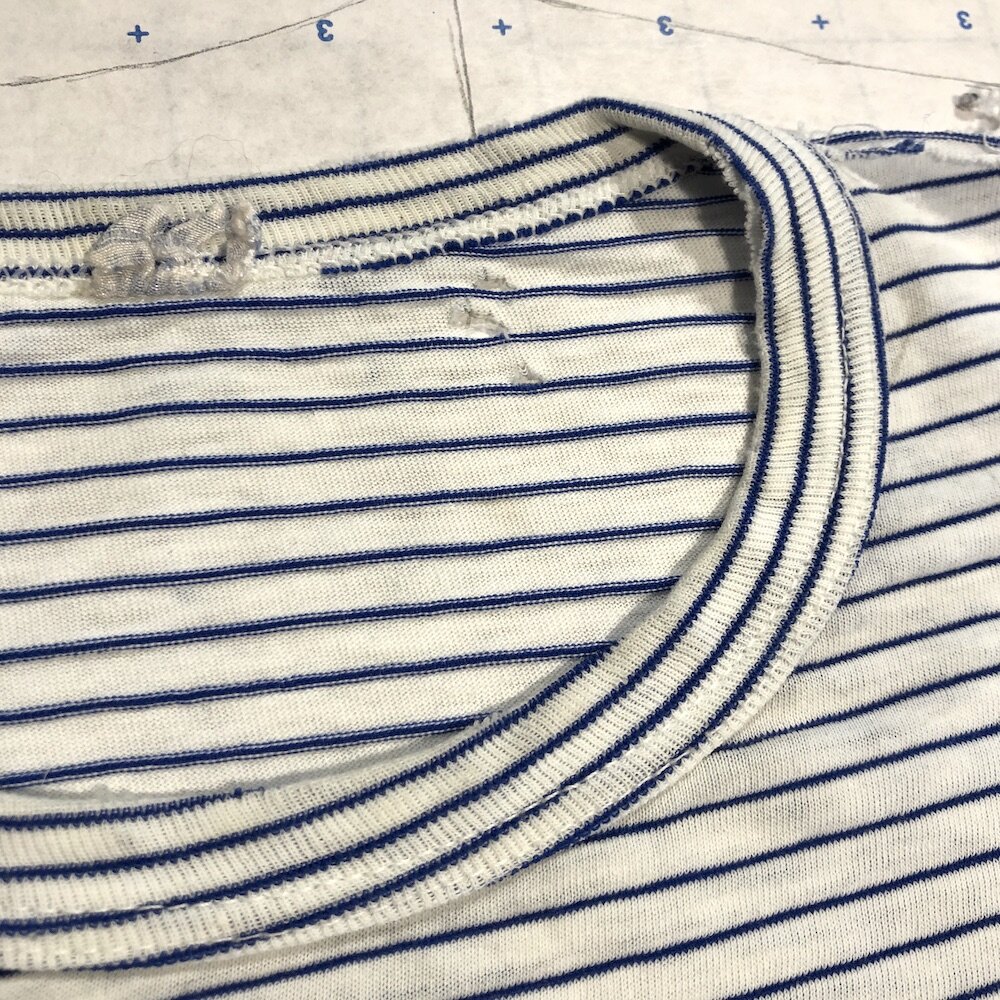A special t-shirt
It’s been over a year since I wrote a blog post on here. I’ve been busy to say the least. However, I’ve accumulated many stories and have yet to share them on this platform, so I thought I might give the old blog another try to share some of these stories more in depth than Instagram allows.
Usually I don’t take on commissions, but occasionally a request comes along that piques my interest. In this case, it was recreating a beloved T-shirt belonging to Jonna (@otto_rumbles) as a birthday gift.
I love the ways that the most simple garments can become treasured objects due to the sensory pleasure they provide or the strong memories tied to them. In this case, it was a well worn cotton t-shirt with a fine, yarn dyed stripe and the perfect fit and drape.
While the shirt itself was simple enough to pattern, tracking down just the right fabric was a process. And with a design this simple, finding the right fabric was crucial to capturing the feeling of the original piece.
I wanted to stay as true as I could to the original shirt: silky and soft 100% cotton with a fluid drape and a subtle yarn dyed stripe. Finding a fabric match for a vintage garment can be quite a challenge, since trends and technologies in manufacturing have changed so much over the years. While I couldn’t find anything exactly like the original, I was able to find something of a similar weight and feel with its own unique special qualities.
I stumbled upon a shop based on the west coast who, among other offerings, had a selection of gorgeous organic cotton knit fabrics. Ecobutterfly is one of those companies that has been offering sustainable and fair trade products since before it was cool. Even their packaging was thoughtfully considered and eco friendly.
How my Ecobutterfly swatch order was packaged
While the color offerings were limited, nestled among the swatches was a gorgeous three tone fine stripe in tan, brown, and green. Upon further inspection, I discovered that the stripes were not dyed but rather yarns spun from color-grown cotton.
If you’re unfamiliar with color grown cotton, you’ll be surprised (and delighted?) to learn that cotton comes in many colors naturally, but monoculture and mass production have pushed the colorful heirloom breeds to the margins. That’s a whole story that we won’t get into here. I’ve known about color grown cotton for a bit by following the amazing work of Sally Fox, a cotton grower and breeder of heirloom colorful cotton. Aside from Fox’s offerings, I haven’t found many color grown textiles on the market these days.
Think that’s nerdy? Here’s where it gets really good…
The original shirt, like many RTW cotton t-shirts, had a knit neckband made from matching rib knit. Specifically, 100% cotton fine 1x1 rib knit.
I may or may not have let out a little squeal when I discovered that not only did Ecobutterfly have lovely, colorgrown organic jersey, but they had rib knit to match! Anyone who spends a lot of time sewing knits knows that finding matching ribbing for a specialty fabric is akin to finding a unicorn! Of course, many RTW garments feature matching ribbing like this, but this is due to textiles being custom manufactured. It’s rare to find matching fine rib knit for sale by the yard. While my client (Jonna’s partner) ultimately decided on the stripe fabric which did not have a matching rib knit, discovering this treasure trove of rib knits was quite a delight.
The right side is all color grown cotton. I ended up eventually purchasing some of the dark brown for a shirt for myself!
As far as construction, I decided to stay true to the original garment, though I did make the neck binding slightly narrower since I was not using a rib knit and the stretch factor was limited. All main seams were sewn with the serger and hems were finished with the cover stitch. I ended up making a total of three shirts, which had me imagining the bespoke version of the classic Fruit of the Loom t-shirt 3 pack.
If you’ve never sewn a knit binding, it’s actually a really lovely finish and not too hard. Inspired by the original construction method, I started by basting the rib knit to the open neckline RST as for a woven binding, making sure to stretch evenly as I sewed. I then wrapped the binding to the wrong side, pressed it, and sewed in place using my coverstitch machine. Afterwards, I trimmed the interior raw edge close to the coverstitch seam and removed the basting stitches. Finally, I sewed up the second shoulder seam, adding a row of stitching to keep the serged seam flat at the neckline. Typically I prefer neckline finishes that enclose all the seams, but I thought it would be good to stay true to the original shirt and I think it’s actually quite a nice finish.
This project reminded me that
1. I actually really love sewing knits, even though I spent many years thinking they were inferior to wovens for heirloom garments
and 2. sometimes there’s a lot of joy in the thoughtful completion of a very uncomplicated project. Especially when the recipient is pleased!
How about you? Do you love to find the nuances in a straightforward project or do you get more excited about the complex and unusual? What do you think about knit garments as ‘heirlooms’?







